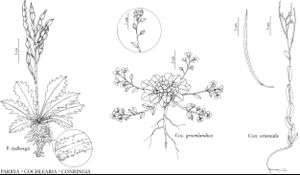Cochlearia
Sp. Pl. 2: 647. 1753.
| Taxon | Illustrator ⠉ | |
|---|---|---|
 | Parrya rydbergii Cochlearia groenlandica Conringia orientalis | Yevonn Wilson-Ramsey Yevonn Wilson-Ramsey Yevonn Wilson-Ramsey |
Annuals, biennials, or, rarely, perennials; not scapose. Stems erect or decumbent, unbranched or branched. Leaves basal and cauline; petiolate or sessile; basal rosulate or not, petiolate, blade margins usually entire, repand, or dentate, rarely sinuate-dentate; cauline petiolate or sessile, blade (base auriculate or not), margins entire, repand, or dentate. Racemes (corymbose), slightly to greatly elongated in fruit. Fruiting pedicels erect, divaricate, or ascending, slender. Flowers: sepals ovate or oblong; petals oblanceolate or spatulate, [oblong, lingulate, elliptic], claw not differentiated from blade; stamens subequal or slightly tetradynamous; filaments not dilated basally; anthers ovate; nectar glands lateral, 1 on each side lateral stamens. Fruits sessile, ovoid, ellipsoid, obovoid, orbicular, ovoid-orbicular, or elliptic to oblong, [sub] terete or angustiseptate; valves each with distinct midvein (sometimes inflated); replum rounded; septum complete, fenestrate, or absent; ovules [5–] 8–14 [–32] per ovary; stigma capitate. Seeds plump, not winged, ovoid-oblong or ovoid to subglobose [ellipsoid]; seed-coat (smooth or papillose), not mucilaginous when wetted; cotyledons accumbent, rarely incumbent. x = 6, 7.
Distribution
North America, Europe, Asia, nw Africa
Discussion
Species 21 (3 in the flora).
Molecular data (M. Koch et al. 1999) provide some evidence that Ionopsidium Reichenbach could be integrated into Cochlearia as a section, consisting of at least five species in Eurasia.
Molecular studies (M. Koch 2002; Koch et al. 1996, 1998, 1999, 2003) as well as cytological ones (D. M. Pegtel 1999, and references therein) have demonstrated that in Cochlearia hybridization and polyploidization have created in Europe extensive complexes based on x = 6; the circumpolar and subarctic taxa form different complexes based on x = 7. It appears that all North American taxa belong to the latter group. The North American taxa have not been studied as comprehensively as the European ones.
Selected References
Key
| 1 | Annuals; fruits oblong or elliptic, 8-12 mm; stems simple from base; cauline leaves sessile, blade margins entire, rarely repand. | Cochlearia sessilifolia |
| 1 | Biennials or perennials; fruits ovoid, obovoid, orbicular, or ellipsoid, rarely to 9 mm; stems usually few to several from base; (proximal) cauline leaves petiolate, blade margins dentate, repand, or entire | > 2 |
| 2 | Fruits obovoid, ovoid, or ellipsoid, terete or slightly angustiseptate, valves usually not or obscurely reticulate, rarely distinctly so; proximal and median cauline blades: margins entire, repand, or slightly dentate. | Cochlearia groenlandica |
| 2 | Fruits orbicular or ovoid-orbicular, distinctly angustiseptate, valves prominently reticulate; proximal and median cauline blades: margins dentate. | Cochlearia tridactylites |
"elongated" is not a number."thick" is not a number.